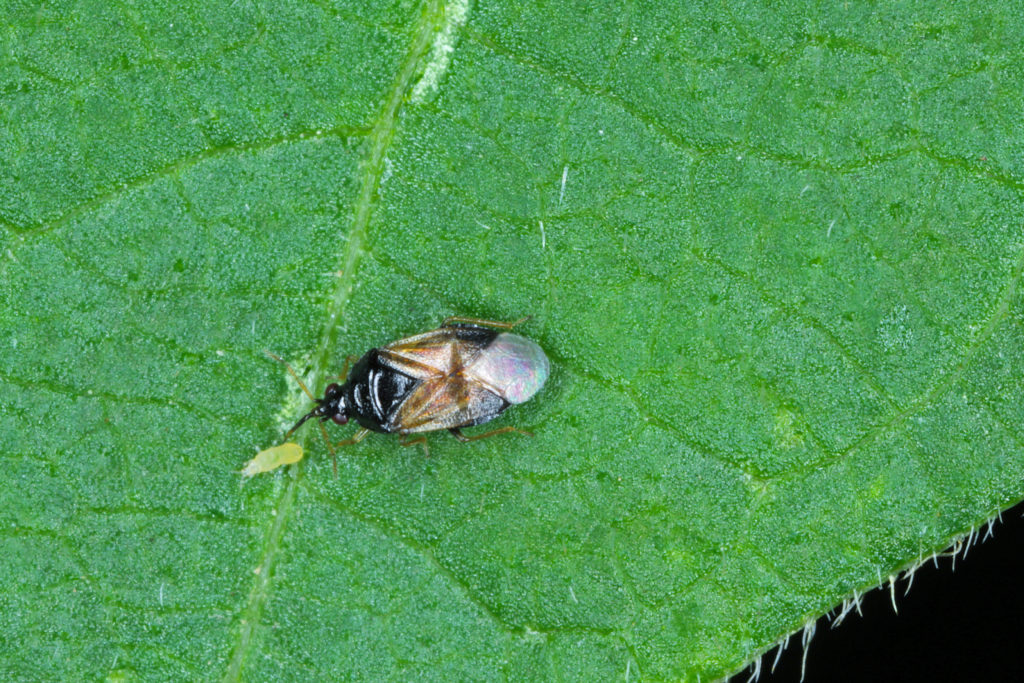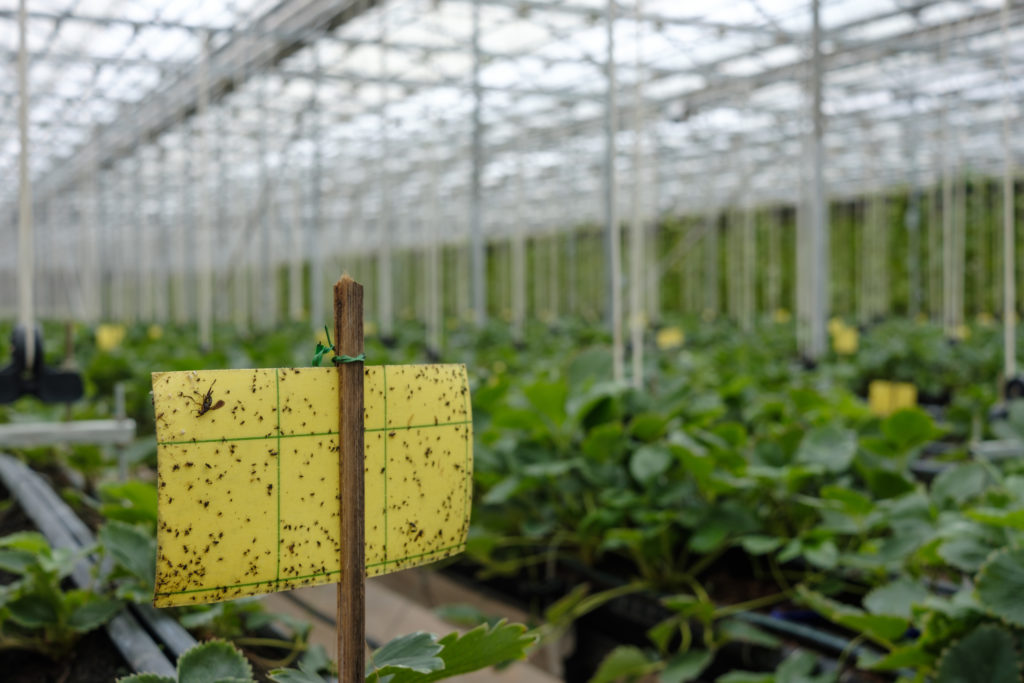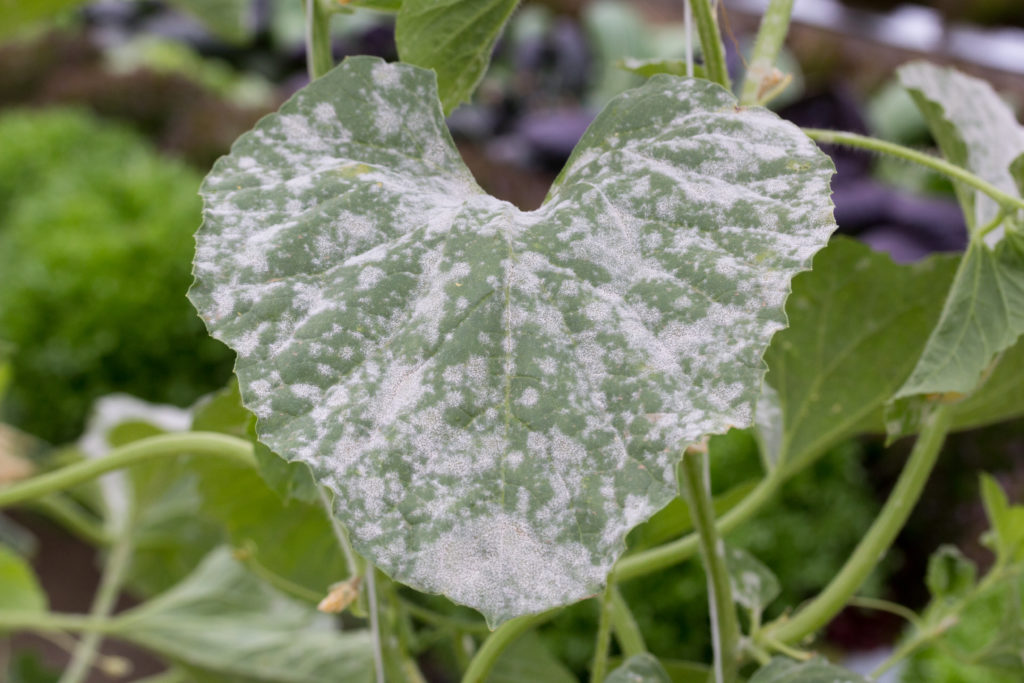A limiting factor for winter greenhouse production is having low natural light levels. To combat low intensities and shorter daylength growers will supplement with artificial lighting to maximize their growing potential. So, how does adding artificial lighting to your growing operation affect your IPM (integrated pest management) program?
Factors of the light environment that influence pests, disease and beneficial insects are light intensity, light quality and photoperiod. When you add supplemental lighting to your growing operation your IPM program can be affected in different ways, especially when biocontrols are being utilized.
What are biocontrols?
Biological controls (“biocontrols” or “bios”) are referred to as the reduction of a pest population by natural enemies. In a recent survey by Vineland Research, they found that 92% of floriculture operations now use biocontrols as part of their IPM program, reflecting an overall movement in the horticulture industry towards biocontrol use. Predators, parasitoids and pathogens can all be natural enemies of unwanted pests. By introducing certain natural enemies into your growing operation, you may be able to help control pest populations without the use of pesticides or chemicals. These natural enemies are often bought through a supplier or can be reared in-house on a banker plant system. Utilizing biological controls in your growing operation, as part of your IPM program, can be a sustainable and long-term solution to manage pests and disease. For this article I got the opportunity to speak with biocontrol experts Michael Brownbridge and Rose Buitenhuis of Vineland Research about how using biological controls in conjunction with supplemental lighting could affect or enhance your pest management strategies.

Photoperiod
Photoperiod is critical for diapause induction in certain biological controls. Diapause is the delay in development in response to regularly recurring environmental conditions. In other words, it’s like an insect hibernation, which is most often observed in the winter months.
Orius Insidiosus, an important predator of thrips and other greenhouse pests, goes through diapause in the winter months. Orius needs at least 12 hours of light to break diapause and this can be achieved through supplemental lighting such as low intensity photoperiod lighting. Another beneficial, Aphidoletes aphidimyza, a predatory midge whose larvae attack up to 70 aphid species including the green peach aphid and potato aphid, also goes through a diapause in the winter months. They respond to cooler temperatures and shorter days (less than 16 hours) and this again, can be broken when using supplemental lighting, even at low intensities. Aphidoletes is most active at night and will need warm temperatures above 20 degrees to still be viable. Overall, having supplemental lighting will have a positive effect on breaking diapause in certain important beneficial insects.

Light Intensity
Light intensity can also affect the behaviour and dispersal of certain insects. There has been research explaining that higher light intensities can increase the parasitism rates of two important whitefly parasitoids, Encarsia Formosa and Eretmocerus Eremicus (Johansen, et al. 2011). Longer photoperiods also had a positive effect on foraging activity and parasitism. Using supplemental lighting can thus contribute to a better outcome in your IPM program, especially where whitefly can be an issue in winter months. Overall, lighting intensity looks to have a positive effect on most beneficials either through increased parasitism, mobility, dispersal, predation or laying eggs at higher rates.
Light Intensity can also affect pests’ behaviour. It has been researched that with higher light intensities, whitefly is more attracted to blue sticky traps and fungus gnats tend to be more attracted to yellow sticky traps (Johansen, et al. 2011). Therefore, lighting could also play a role in mass trapping of certain pest species.

Light for disease control
The use of low intensity red light at night can help control downy mildew from sporulating and spreading within the crop. Research conducted by the Lighting Research Institute has found that red light suppresses downy mildew in basil and even had a positive effect on the basil plants themselves, including increased leaf number and size. Downy mildew sporulates and spreads at night under high humidity, which is why the red-light treatment is done at night to help prevent its spread.
Night-time treatments of UV-light may also help suppress powdery mildew in several crops including cucumber and strawberry. Researchers have found that using UV wavelengths helps break down the pathogen’s DNA. Blue light on the other hand repairs the DNA, which is why lighting with both blue and UV spectrums do not prevent the disease from sporulating. There is more research being conducted on strawberry that is showing positive results from UV light at night, and that UV treatments applied once or twice weekly were as effective as the best available fungicides applied on similar schedules for control of strawberry powdery mildew.
There is still a lot of research to be done of how these light treatments will affect plant health, but it is encouraging to see that light can play a potentially important role in a grower’s IPM program and may lead to a more sustainable approach to disease management.

Things to consider:
Everything is a balance – lighting cannot solve your pest and disease problems, but it may help give you more solutions to work with. It should first begin with making sure that your crop is getting everything it needs in terms of water, nutrients, environmental conditions and so on, as well as understanding why a pest and/or disease problem occurs in the first place. What lighting can provide is an extra tool when deciding what bios to use, especially in low light conditions, as using supplemental light can help increase the chances of a biocontrol finishing their life cycle thus leading to a higher success rate with your IPM program. It also means choosing the biological control that is best suited to your growing environment, and making sure you take lighting, temperature and other environmental factors into consideration when introducing one. Using a well thought out IPM program and coming up with strategies to manage pests and disease before they become an issue is when you are likely to see higher success.
To learn more about biocontrol strategies for your growing operation, watch this video by Vineland Research.
References:
Cochard P., T. Galstian, C. Cloutier. 2017. Light Environments Differently Affect Parasitoid Wasps and their Hosts’ Locomotor Activity. Journal of Insect Behaviour 30:595-611.
Joansen N.S., I. Vanninen, D.M. Pinto, A.I. Nissinen & L. Shipp. 2011. In the light of new greenhouse technologies: 2. Direct effects of artificial lighting on anthropods and integrated pest management in greenhouse crops. Annals of Applied Biology 159:1-27.

Jill Whitehead is a digital marketing specialist with P.L. Light Systems and brings over 10 years of experience in the agricultural industry. Prior to joining P.L. Light Systems Jill worked as grower running her own farm business.


